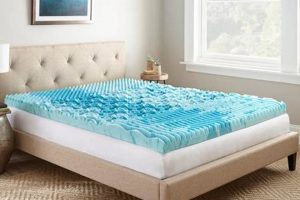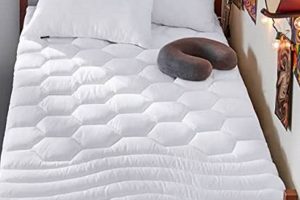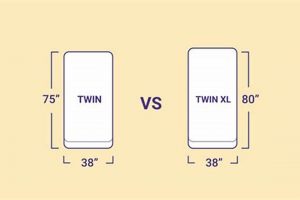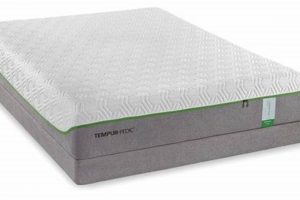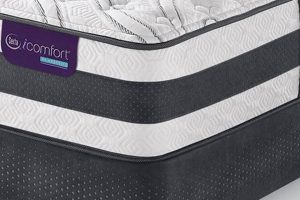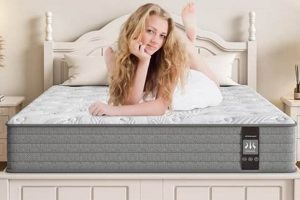A bed designed for individual customization and comfort, this type of sleep system features a longer-than-standard single mattress capable of being repositioned at the head and foot. Such a bed is particularly suited for single sleepers needing or desiring personalized support. An example would be someone who likes to read in bed and wants the head of the mattress raised without using pillows, or someone with back pain who benefits from elevating their legs.
These sleep solutions address specific needs that a standard flat mattress cannot. The advantages range from improved circulation and reduced pressure points to enhanced comfort for activities like reading or watching television in bed. Their origins stem from the healthcare sector, where adjustable beds have long been used to aid patient recovery and comfort. Over time, this technology has made its way into the consumer market, driven by a growing awareness of the importance of sleep posture and individual comfort preferences.
The following sections will explore specific considerations when selecting this type of product, including size specifications, motor mechanisms, frame materials, and compatible mattress types. Furthermore, the discussion will cover warranty information, return policies, and factors impacting long-term durability and performance.
Selection & Maintenance Guidance
The following guidelines offer critical insight into the acquisition and care of a twin XL adjustable mattress, emphasizing factors that directly impact its lifespan, performance, and suitability for individual needs.
Tip 1: Motor Quality: Evaluate the motor’s specifications regarding noise level and lifting capacity. A quieter motor ensures minimal disturbance during adjustments, and sufficient lifting capacity accommodates the user’s weight plus any bedding.
Tip 2: Frame Construction: Inspect the frame material and welding quality. Steel frames with reinforced welds provide greater structural integrity and long-term stability, resisting bending or breakage under repeated use.
Tip 3: Mattress Compatibility: Confirm that the mattress is specifically designed for adjustable bed frames. Incompatible mattresses may experience premature wear or inhibit the bed’s range of motion.
Tip 4: Remote Functionality: Assess the remote control’s features, including ease of use, programmable positions, and backlighting. A user-friendly remote enhances the convenience and accessibility of the bed’s adjustability.
Tip 5: Warranty Coverage: Review the warranty terms carefully, noting the duration of coverage and the specific components protected. Extended warranties offer increased protection against manufacturing defects and mechanical failures.
Tip 6: Regular Maintenance: Adhere to the manufacturer’s recommended maintenance schedule, including lubrication of moving parts and inspection of electrical connections. Consistent maintenance extends the bed’s operational life.
Tip 7: Weight Distribution: Distribute weight evenly across the mattress surface to prevent localized stress and potential damage to the adjustable mechanism. Avoid concentrated pressure points or excessive loading.
Adhering to these considerations during purchase and maintenance ensures optimal performance and maximizes the lifespan of the adjustable mattress system.
The subsequent sections will delve into troubleshooting common issues and providing guidance on optimizing the user experience.
1. Dimensions
The dimensions of a twin XL adjustable mattress are a primary consideration, influencing not only its fit within a room but also its suitability for the individual sleeper. Standardized measurements provide a baseline, while variations may exist across manufacturers.
- Length
A key characteristic of the twin XL size is its extended length compared to a standard twin. This extra length, typically 80 inches, provides sufficient legroom for taller individuals who might otherwise find a standard twin mattress too short. This is particularly relevant given the adjustable base, as proper leg support is essential for optimized comfort in various reclined positions.
- Width
The width of a twin XL adjustable mattress remains consistent with a standard twin, measuring approximately 38 inches. This limited width is appropriate for single sleepers and smaller spaces. However, the adjustable functionality allows the single user to maximize their comfort zone within the constrained width by customizing the mattress’s contours.
- Height
The height of the mattress itself, independent of the adjustable base, can vary considerably depending on the materials used (memory foam, innerspring, etc.). Height can impact ease of getting in and out of bed, especially when combined with the added height of the adjustable base. Furthermore, the combined height influences the selection of appropriate bedding, such as sheets and bed skirts.
- Base Dimensions
In addition to the mattress dimensions, the dimensions of the adjustable base must be considered. These dimensions impact the overall footprint of the bed within the room and dictate whether the base will fit within an existing bed frame (if desired). The base dimensions also influence the range of motion, or the maximum angles to which the head and foot of the bed can be raised.
The precise dimensions of a twin XL adjustable mattress and its corresponding base are thus crucial factors. Accurate measurements ensure compatibility with bedroom space and accommodate the individual’s physical needs and preferences regarding comfort and ease of use in various reclining positions.
2. Adjustability
Adjustability represents a core feature differentiating a twin XL adjustable mattress from its standard counterpart. This functionality allows for customized positioning of the sleep surface, offering potential benefits for comfort, health, and lifestyle.
- Head and Foot Articulation
The primary manifestation of adjustability involves the independent raising and lowering of the head and foot sections of the mattress. This enables users to achieve positions such as a reclined posture for reading or television viewing, or elevation of the legs to promote circulation and reduce swelling. For individuals with specific medical conditions like acid reflux or sleep apnea, these adjustments may offer therapeutic advantages.
- Pre-set Positions and Programmability
Many twin XL adjustable mattresses offer pre-set positions for common activities like reading, watching television, or zero-gravity alignment. Furthermore, higher-end models often include programmable positions, allowing users to save their preferred configurations for instant recall. This feature enhances convenience and allows for consistent comfort customization.
- Massage Functionality
Some adjustable mattresses incorporate massage features, utilizing vibrating motors to provide localized stimulation. These massage functions often offer adjustable intensity levels and various massage patterns, potentially contributing to relaxation and pain relief. While not directly related to postural adjustment, massage functionality enhances the overall user experience.
- Wireless Remote Control and App Integration
Modern twin XL adjustable mattresses typically utilize wireless remote controls for intuitive operation. Many also offer smartphone app integration, providing advanced control options and customization features. These interfaces allow users to fine-tune the bed’s position with precision and save personalized settings for future use.
The degree of adjustability, the precision of control, and the integration of supplemental features such as massage directly influence the overall utility and appeal of a twin XL adjustable mattress. These factors should be carefully evaluated in light of individual needs and preferences to ensure optimal satisfaction.
3. Mattress type
The selection of mattress type is paramount when considering a twin XL adjustable mattress, as it directly impacts both comfort and the long-term performance of the adjustable base. Not all mattress materials are equally suited for the bending and flexing inherent in adjustable bed frames.
- Memory Foam
Memory foam mattresses are frequently recommended for adjustable beds due to their inherent flexibility and ability to conform to the contours of the base without compromising support. A memory foam mattress readily bends and returns to its original shape, minimizing stress on the material and ensuring even weight distribution across the adjustable surface. The density of the memory foam should be considered, as higher-density foams may exhibit greater resistance to bending and a reduced lifespan on an adjustable base. An example would be a multi-layered memory foam mattress with varying densities to optimize both comfort and flexibility.
- Latex
Latex mattresses, particularly those made from natural latex, also demonstrate excellent flexibility and durability on adjustable bed frames. Natural latex possesses inherent elasticity, allowing it to bend and flex without significant distortion or wear. Synthetic latex may offer similar flexibility but may not match the long-term durability of natural latex. A suitable choice might be a Dunlop latex mattress, known for its dense and resilient composition, ideal for supporting adjustable positioning while maintaining consistent comfort.
- Innerspring
Traditional innerspring mattresses are generally less compatible with adjustable beds. The interconnected coil systems within innerspring mattresses limit their ability to conform to the adjustable base, potentially leading to premature wear and tear or reduced comfort. Pocketed coil systems, where each coil is individually wrapped, offer a slightly improved degree of flexibility compared to traditional innerspring mattresses; however, they still do not match the flexibility of memory foam or latex. In the context of a twin XL adjustable mattress, an innerspring model might exhibit uneven wear and reduced support in the flex points over time.
- Hybrid
Hybrid mattresses, combining elements of innerspring and foam construction, can offer a compromise between support and flexibility. The suitability of a hybrid mattress for an adjustable bed depends largely on the ratio of innerspring coils to foam layers and the specific construction techniques employed. A hybrid mattress with a substantial layer of flexible memory foam or latex atop a pocketed coil system may provide adequate flexibility for adjustable bases, while still offering the support and responsiveness of an innerspring system. A careful evaluation of the materials and construction is critical to determine its compatibility with a twin XL adjustable mattress.
The selection of a compatible mattress type directly influences the longevity, comfort, and functional performance of a twin XL adjustable mattress system. Prioritizing flexible materials like memory foam or latex, while carefully considering the construction of hybrid models, ensures optimal utilization of the adjustable base features and extends the overall lifespan of the sleep system.
4. Motor Strength
Motor strength is a critical determinant of the performance and longevity of a twin XL adjustable mattress system. The motor’s capacity directly influences its ability to lift and support the weight of the mattress and the occupant, while also affecting the smoothness and quietness of adjustments.
- Lifting Capacity
Lifting capacity, measured in pounds or kilograms, indicates the maximum weight the motor can reliably lift and support. Selecting a motor with insufficient lifting capacity can lead to strain, premature failure, and compromised functionality. An example would be a motor rated for 300 lbs attempting to lift a 250 lb individual on a 75 lb mattress. This exceeds the recommended load and can result in slow, jerky movements or even motor burnout. A motor with a higher rating (e.g., 400 lbs) provides a safety margin and ensures smooth operation under load.
- Duty Cycle
The duty cycle specifies the percentage of time a motor can operate within a given period without overheating or experiencing damage. A motor with a short duty cycle might only be capable of operating for a few minutes continuously before requiring a cooling period. For frequent adjustments, a motor with a higher duty cycle is essential. An example is a motor with a 20% duty cycle, meaning it can operate for 2 minutes out of every 10 minutes. If the bed is adjusted frequently for extended periods, this duty cycle will likely be insufficient, leading to overheating and potential failure.
- Noise Level
Motor strength is often correlated with noise level. Weaker motors may strain under load, producing louder operating sounds. Conversely, well-engineered, powerful motors can operate more quietly and smoothly. The noise generated by the motor can impact the sleep environment, especially if adjustments are made during the night. For example, a motor producing a high-pitched whine or a loud grinding noise can disrupt sleep and reduce the overall user experience.
- Durability and Lifespan
A robust motor with ample power and a suitable duty cycle contributes significantly to the overall durability and lifespan of the adjustable mattress system. A stressed or underpowered motor is prone to early failure, necessitating costly repairs or replacement. Selecting a motor from a reputable manufacturer with a proven track record of reliability is crucial for ensuring long-term satisfaction. An example is comparing two motors with identical lifting capacities, but one is from a manufacturer known for using high-quality components and rigorous testing, while the other is from a generic brand with limited information. The former is likely to offer superior durability and a longer lifespan.
The motor’s strength and operational characteristics are thus integral to the overall functionality and long-term value of the twin XL adjustable mattress. Attention to lifting capacity, duty cycle, noise level, and manufacturer reputation ensures that the motor can reliably and quietly deliver the desired adjustments, contributing to a comfortable and durable sleep solution.
5. Frame Support
Frame support is an indispensable element of a twin XL adjustable mattress system, providing the structural foundation necessary for the device to function correctly and maintain its integrity over time. The frame must withstand the dynamic forces generated by the adjustable mechanism and the weight of the mattress and occupant.
- Material Composition
The materials used in the frame construction dictate its strength and resistance to deformation. Steel frames, particularly those utilizing high-gauge steel, offer superior load-bearing capacity and long-term durability compared to frames constructed from wood or lower-quality metals. An example would be comparing a frame made of 14-gauge steel to one made of 18-gauge steel; the 14-gauge steel frame will provide greater resistance to bending and twisting under load. Furthermore, the presence of reinforcing gussets and welded joints enhances the overall rigidity of the frame.
- Weight Distribution
The design of the frame directly impacts how weight is distributed across its structure. A well-designed frame ensures that weight is evenly distributed, minimizing stress concentrations and preventing localized failures. An improperly designed frame may exhibit weak points where stress is concentrated, leading to premature wear or breakage. For instance, a frame with inadequate support in the center section may sag under load, compromising the adjustable mechanism and potentially damaging the mattress.
- Adjustable Mechanism Integration
The frame must seamlessly integrate with the adjustable mechanism, providing secure mounting points and allowing for smooth, unrestricted movement. Poor integration can result in binding, uneven articulation, and increased stress on the motor and other components. For example, if the hinges connecting the adjustable sections to the frame are poorly aligned or inadequately supported, the bed may exhibit jerky movements or excessive noise during adjustments.
- Stability and Floor Contact
The frame must provide a stable and level platform, ensuring that the adjustable mattress remains secure and does not rock or wobble during operation. Adequate floor contact points, typically in the form of adjustable legs or casters, are essential for maintaining stability and preventing damage to flooring. For instance, a frame with insufficient floor contact may be prone to tipping or shifting during adjustments, posing a safety hazard and potentially damaging the adjustable mechanism.
In summation, robust frame support is paramount for the safe, reliable, and long-lasting operation of a twin XL adjustable mattress. Careful consideration of material composition, weight distribution, adjustable mechanism integration, and stability ensures that the frame can effectively support the adjustable mattress and its occupant, providing a comfortable and functional sleep environment.
6. Remote controls
Remote controls are an integral component of modern twin XL adjustable mattress systems, facilitating user interaction and enabling the manipulation of the bed’s adjustable features. The design, functionality, and reliability of the remote control significantly influence the overall user experience and the perceived value of the adjustable bed.
- Ergonomics and Usability
The physical design of the remote control impacts its ease of use and comfort in hand. A well-designed remote features intuitive button placement, clear labeling, and a comfortable grip, minimizing the learning curve and allowing for effortless adjustments. An example would be a remote with raised, tactile buttons for users with limited dexterity or visual impairments. The absence of ergonomic design can lead to frustration and difficulty in operating the bed, particularly for elderly or infirm individuals.
- Functionality and Programmability
Remote controls offer a range of functionalities, from basic head and foot elevation adjustments to advanced features such as pre-set positions and programmable memory settings. Pre-set positions typically include configurations like “zero gravity” or “reading mode,” while programmable memory allows users to store their preferred bed positions for instant recall. An example is a remote that allows the user to program a custom position for alleviating back pain or reducing snoring. Limited functionality restricts user customization and reduces the potential benefits of the adjustable bed.
- Wireless Connectivity and Reliability
Remote controls typically utilize wireless technology, such as radio frequency (RF) or Bluetooth, to communicate with the adjustable bed’s control system. Reliable wireless connectivity is essential for consistent and responsive operation. Interference from other electronic devices or weak signal strength can result in delayed responses or intermittent functionality. For example, a remote that frequently disconnects from the bed requires repeated pairing or repositioning to establish a stable connection. The reliability of the wireless connection directly impacts the user’s ability to control the bed effectively.
- Backlighting and Visibility
Backlighting enhances the visibility of the remote control’s buttons in low-light conditions, facilitating nighttime adjustments without requiring additional illumination. Backlit buttons allow users to easily identify and select the desired function without disturbing their sleep partner or needing to turn on a lamp. A remote without backlighting can be difficult to use in a darkened room, particularly for individuals with impaired vision. An example would be a remote with dimmable backlighting, allowing users to adjust the brightness to their preference.
The capabilities and characteristics of the remote control are, therefore, critical factors in the overall utility and convenience of a twin XL adjustable mattress. A well-designed, functional, and reliable remote enhances the user’s ability to personalize their sleep environment and maximize the benefits of the adjustable bed system.
7. Sleep comfort
Sleep comfort, a multifaceted concept encompassing physical and psychological well-being during sleep, is a primary consideration in the design and functionality of a twin XL adjustable mattress. The adjustable nature of the bed aims to directly enhance sleep comfort by providing customizable support and positioning.
- Pressure Relief and Support
Adjustable mattresses allow for targeted pressure relief by modifying the sleeping surface to conform to the body’s natural contours. Elevating the head and legs can reduce pressure on the spine and joints, promoting better circulation and minimizing discomfort. For example, individuals with chronic back pain may find relief by elevating their knees, which reduces pressure on the lower back. Conversely, customized support ensures proper spinal alignment, preventing aches and pains that can disrupt sleep.
- Temperature Regulation
While not directly an inherent function of the adjustability, the mattress material chosen for a twin XL adjustable mattress significantly impacts temperature regulation. Materials like memory foam can trap heat, while latex or hybrid mattresses with breathable layers can promote airflow and prevent overheating. Adjustable positioning can also indirectly influence temperature by allowing the user to find a position that maximizes airflow around their body. For instance, slightly elevating the upper body can improve ventilation and reduce perspiration.
- Individualized Comfort Preferences
Sleep comfort is subjective and varies from person to person. Adjustable mattresses cater to individualized preferences by allowing users to fine-tune the bed’s position to suit their unique needs and comfort levels. Some individuals may prefer a reclined position for reading or watching television, while others may find a flatter surface more conducive to sleep. The ability to customize the bed’s configuration ensures that each user can optimize their sleep environment for maximum comfort. An example would be one user preferring a slightly inclined position to alleviate sleep apnea, while another might opt for a flat surface for optimal spinal alignment.
- Reduction of Sleep Disturbances
By addressing factors such as pressure points, discomfort, and improper alignment, adjustable mattresses can contribute to a reduction in sleep disturbances. Minimizing tossing and turning, alleviating pain, and promoting better circulation can result in a more restful and uninterrupted sleep. This, in turn, can lead to improved daytime alertness, cognitive function, and overall well-being. An example would be a user experiencing fewer episodes of nocturnal leg cramps due to improved circulation achieved by elevating their legs during sleep.
These facets of sleep comfort are directly addressed by the features and design of a twin XL adjustable mattress. By providing customizable support, addressing temperature regulation, and catering to individual preferences, adjustable mattresses aim to optimize the sleep environment and enhance overall well-being. The specific materials, construction, and adjustability features should be carefully considered to ensure the selected mattress effectively addresses the individual’s unique sleep comfort needs.
Frequently Asked Questions
The following section addresses common inquiries regarding twin XL adjustable mattresses, providing concise and informative answers to guide potential buyers and current owners.
Question 1: What are the dimensions of a twin XL adjustable mattress?
A twin XL adjustable mattress typically measures 38 inches in width and 80 inches in length. This longer length distinguishes it from a standard twin mattress, providing additional legroom for taller individuals. The height varies depending on the mattress type and construction.
Question 2: What mattress types are compatible with adjustable bed frames?
Memory foam and latex mattresses are generally considered the most compatible with adjustable bed frames due to their flexibility and ability to conform to the bed’s contours. Innerspring mattresses are less suitable, while hybrid mattresses may offer a compromise depending on their construction.
Question 3: What is the weight capacity of a typical twin XL adjustable mattress frame?
The weight capacity varies depending on the specific model and manufacturer. However, most twin XL adjustable mattress frames are designed to support a combined weight of at least 350 pounds, including the mattress and the occupant. Consult the manufacturer’s specifications for precise weight limits.
Question 4: What features should one consider when selecting an adjustable bed remote control?
Key considerations include ergonomic design, intuitive button placement, pre-set positions, programmable memory settings, wireless connectivity reliability, and backlighting for nighttime use.
Question 5: How often should a twin XL adjustable mattress be cleaned or maintained?
Regular cleaning is recommended to maintain hygiene and prolong the mattress’s lifespan. Vacuuming the mattress surface every few months helps remove dust and allergens. Spot cleaning stains with a mild detergent and water is also advisable. Consult the manufacturer’s instructions for specific cleaning recommendations.
Question 6: What is the typical warranty coverage for a twin XL adjustable mattress and frame?
Warranty coverage varies depending on the manufacturer and model. However, a typical warranty may cover the frame’s structural components for several years, while the motor and electrical components may have a shorter warranty period. Review the warranty terms carefully before purchasing.
These FAQs provide a foundational understanding of twin XL adjustable mattresses. For specific inquiries, consult product manuals or seek expert advice.
The ensuing sections will delve into troubleshooting common issues and providing guidance on optimizing the user experience of these products.
Twin XL Adjustable Mattress
This exploration has illuminated the various facets of the twin XL adjustable mattress, ranging from its dimensional characteristics and adjustability options to crucial aspects such as mattress compatibility, motor strength, frame support, and remote control functionalities. An understanding of these elements is paramount for making informed purchasing decisions and ensuring long-term satisfaction with this type of sleep system. The selection process should be guided by individual needs, preferences, and a careful assessment of product specifications.
The adoption of a twin XL adjustable mattress represents a commitment to personalized sleep comfort and optimized well-being. Continued advancements in materials science, motor technology, and ergonomic design are expected to further enhance the capabilities and benefits of these systems in the future. Prospective consumers are encouraged to remain informed and prioritize quality, durability, and individual suitability when considering this significant investment in their sleep health.


